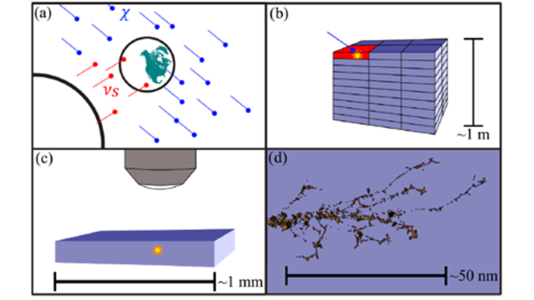
Scientific Achievement
This paper outlines the vision for a solid-state directional detector of weakly interacting massive particles (WIMPs) that integrates real-time event registration, three-dimensional directional information and high-density target material.
Significance and Impact
Directional detectors improve sensitivity to WIMP dark matter and overcome the challenge of irreducible neutrino background. A future WIMP detector will leverage or motivate advances in multiple disciplines toward precision dark matter and neutrino physics.
Research Details
- The detector operates in hybrid mode: nuclear recoil event registration is performed in real-time using charge, phonon or photon collection.
- The solid-state detector using quantum defects in diamond would provide timing information and complete three-dimensional information via head/tail asymmetric signals.
Work performed in part at the Center for Nanoscale Materials and Advanced Photon Source, DOE Office of Science user facilities.
DOI: 10.1116/5.0117301
About Argonne’s Center for Nanoscale Materials
The Center for Nanoscale Materials is one of the five DOE Nanoscale Science Research Centers, premier national user facilities for interdisciplinary research at the nanoscale supported by the DOE Office of Science. Together the NSRCs comprise a suite of complementary facilities that provide researchers with state-of-the-art capabilities to fabricate, process, characterize and model nanoscale materials, and constitute the largest infrastructure investment of the National Nanotechnology Initiative. The NSRCs are located at DOE’s Argonne, Brookhaven, Lawrence Berkeley, Oak Ridge, Sandia and Los Alamos National Laboratories. For more information about the DOE NSRCs, please visit https://science.osti.gov/User-Facilities/User-Facilities-at-a-Glance.
Argonne National Laboratory seeks solutions to pressing national problems in science and technology. The nation’s first national laboratory, Argonne conducts leading-edge basic and applied scientific research in virtually every scientific discipline. Argonne researchers work closely with researchers from hundreds of companies, universities, and federal, state and municipal agencies to help them solve their specific problems, advance America’s scientific leadership and prepare the nation for a better future. With employees from more than 60 nations, Argonne is managed by UChicago Argonne, LLC for the U.S. Department of Energy’s Office of Science.
The U.S. Department of Energy’s Office of Science is the single largest supporter of basic research in the physical sciences in the United States and is working to address some of the most pressing challenges of our time. For more information, visit https://energy.gov/science.